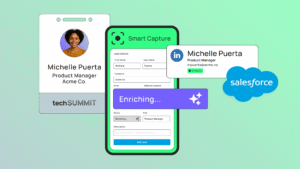
Why Is It So Hard to Prove Higher Ed Event ROI?
You’ve invested thousands into recruitment fairs, alumni galas, and campus events, but can you prove they worked? Without clear ROI, it’s not just budget on the line—it’s your credibility with leadership.
Despite increased investment in events, institutions often grapple with disconnected data, manual processes, and limited integrations, hindering their ability to demonstrate tangible outcomes. But with the right strategy and technology, measuring higher ed event ROI can become a core strength, not a guessing game.
The Importance of Events in Higher Education
Events are pivotal in the higher education landscape, serving various purposes:
- Student Recruitment: Open houses and campus tours introduce prospective students to campus life.
- Alumni Engagement: Reunions and fundraisers strengthen alumni bonds and encourage giving.
- Academic Showcases: Conferences and symposiums highlight research and academic excellence.
However, the effectiveness of these events is often undermined by the inability to measure their impact accurately.
Common Challenges in Measuring Higher Ed Event ROI
1. Fragmented Data Systems
Many institutions use multiple platforms for event registration, communication, and data management. This fragmentation leads to:
- Inconsistent data across systems.
- Difficulty in tracking attendee engagement.
- Challenges in attributing outcomes to specific events.
2. Manual Processes
Reliance on spreadsheets and manual data entry increases the risk of errors and consumes valuable staff time. It also hampers real-time decision-making and post-event analysis.
3. Lack of Clear Metrics
Without predefined goals and KPIs, it’s challenging to assess an event’s success. Institutions often focus on easily measurable metrics like attendance, neglecting more impactful indicators such as:
- Conversion rates from attendees to applicants or donors.
- Engagement levels during and after the event.
- Long-term impact on student retention or alumni giving.
The longer event data stays siloed, the harder it becomes to justify budgets, optimize outreach, or prove your team’s impact. In today’s data-driven environment, vague results aren’t enough, especially when leadership is under pressure to cut costs and show outcomes.
Strategies to Enhance Event ROI Measurement

1. Choose a Salesforce-Native Solution
Opting for an event management platform that is built natively within Salesforce enables your institution to:
- Centralize data collection within your existing CRM environment.
- Track attendee interactions in real time, directly on contact and campaign records.
- Personalize follow-up communications using accurate, live Salesforce data.
2. Automate Processes
Automation reduces manual workload and improves accuracy, freeing up your team to focus on strategic tasks rather than repetitive admin. Key areas for automation include:
- Managing registration and ticketing.
- Handling waitlist promotions as spots become available without manual intervention.
- Sending email confirmations and reminders.
- Collecting post-event surveys and feedback.
3. Define Clear Objectives and KPIs
Establishing specific goals for each event enables more effective measurement. Examples include:
- Generate 150 new student applications within 30 days after a recruitment fair at high schools in the Midwest.
- Raise $100,000 in pledged donations during the annual alumni gala, with at least 30% coming from first-time donors.
The 3-Part Event ROI Formula
Proving event ROI in higher ed isn’t just about counting heads—it’s about connecting participation to outcomes. This formula helps advancement and enrollment teams tie event activity to institutional impact using Salesforce-native tools.
1. Connect Attendance to Outcomes
It starts with capturing who attended, and linking that to the outcomes that matter. In Salesforce, this means:
- Using Campaigns to track registrants and attendees in real time
- Connecting those Campaigns to Opportunities (gifts, applications, etc.)
- Enabling Campaign Influence to see how specific events contribute to conversion or giving
Why it matters: Without this link, it’s impossible to tie events to donations, applications, or engagement scores—making ROI invisible to leadership.
2. Track Pre and Post-Event Engagement
The value of an event doesn’t stop at check-in. To understand true impact, track:
- Email opens and clicks before and after the event
- Session-level participation (especially for multi-track events)
- Survey responses, follow-up meeting requests, or donation form submissions
In a Salesforce-native platform, this data rolls up to Contact records, giving you a full engagement picture per individual.
Why it matters: This context helps you separate passive attendees from truly engaged prospects and informs personalized outreach.
3. Report by Segment or Event Type
Not all events serve the same goals. That’s why ROI reporting should be filtered by:
- Audience type (e.g., alumni vs. prospective students)
- Event format (in-person, hybrid, virtual)
- Campaign type (recruitment, stewardship, cultivation)
Use dashboards in Salesforce to track how each type performs over time and which deliver the highest return.
Why it matters: This lets teams focus budget and effort on what works and improve or sunset what doesn’t.
The Role of Salesforce-Native Event Management Software
Imagine walking into your next budget meeting with dashboards that show how your last three events directly influenced giving. By choosing a Salesforce-native event management solution, you unlock real-time insights, eliminate data silos, and give leadership the reporting they expect, including:
- Unified Data: All event-related information resides within Salesforce, ensuring consistency and accessibility.
- Enhanced Reporting: Generate comprehensive reports linking event participation to outcomes like enrollment or donations.
- Improved Communication: Tailor communications based on attendee behavior and preferences.
- Automation Built In: Trigger personalized emails, reminders, and follow-up tasks automatically based on real-time attendance data—no manual exports or syncs required.
- Campaign Influence Tracking: Attribute donations or applications to specific event touchpoints using Salesforce Campaigns and Opportunity records.
Show the Value of Every Event
Demonstrating higher ed event ROI requires a strategic approach that combines technology, clear objectives, and efficient processes. By addressing common challenges and leveraging integrated Salesforce-native solutions, institutions can:
- Prove event impact to leadership
- Improve future planning and outreach
- Build stronger, data-informed relationships with students, alumni, and donors
With the right tools, event ROI becomes measurable, repeatable, and impossible to ignore.
Ready to stop juggling tools and start running smarter events?
Schedule a demo and see how Blackthorn works inside Salesforce.


